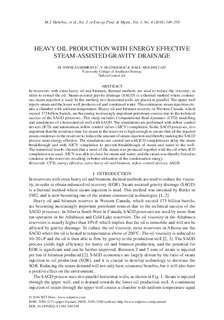| dc.contributor.author | Høhrbye, Elin-Madeleine Jonskås | |
| dc.contributor.author | Mathiesen, Vidar | |
| dc.contributor.author | Moldestad, Britt Margrethe Emilie | |
| dc.date.accessioned | 2017-02-22T14:19:14Z | |
| dc.date.accessioned | 2017-04-19T12:52:14Z | |
| dc.date.available | 2017-02-22T14:19:14Z | |
| dc.date.available | 2017-04-19T12:52:14Z | |
| dc.date.issued | 2016 | |
| dc.identifier.citation | Høhrbye, E-M.J., Mathiesen, V. & Moldestad, B.M. (2016). Heavy Oil Production With Energy Effective Steam-assisted Gravity Drainage. International Journal of Energy Production and Management , vol.1., (4). 349-358. | |
| dc.identifier.issn | N 2056-3272 | |
| dc.identifier.uri | http://hdl.handle.net/11250/2438501 | |
| dc.description.abstract | In reservoirs with extra heavy oil and bitumen, thermal methods are used to reduce the viscosity, in order to extract the oil. Steam-assisted gravity drainage (SAGD) is a thermal method where continuous steam injection is used. In this method, two horizontal wells are placed in parallel. The upper well injects steam and the lower well produces oil and condensed water. The continuous steam injection creates a chamber with uniform temperature. Heavy oil and bitumen reserves in Western Canada, which exceed 175 billion barrels, are becoming increasingly important petroleum sources due to the technical success of the SAGD processes. This study includes Computational fluid dynamics (CFD) modelling and simulations of a horizontal oil well with SAGD. The simulations are performed with inflow control devices (ICD) and autonomous inflow control valves (AICV) completion. In the SAGD processes, it is important that the residence time for steam in the reservoir is high enough to ensure that all the injected steam condenses in the reservoir to reduce the amount of steam injection and thereby making the SAGD process more energy effective. The simulations are carried out with ICD completion to delay the steam breakthrough and with AICV completion to prevent breakthrough of steam and water to the well. The numerical results showed that a most of the steam was produced together with the oil when ICD completion was used. AICV was able to close for steam and water, and the steam was thereby forced to condense in the reservoir, resulting in better utilization of the condensation energy. | |
| dc.language.iso | eng | |
| dc.publisher | Wit Press | |
| dc.subject | CFD | |
| dc.subject | energy effective | |
| dc.subject | extra heavy oil and bitumen | |
| dc.subject | inflow control devices | |
| dc.subject | SAGD | |
| dc.title | Heavy Oil Production With Energy Effective Steam-assisted Gravity Drainage | |
| dc.type | Journal article | |
| dc.type | Peer reviewed | |
| dc.description.version | Published version | |
| dc.identifier.doi | 10.2495/EQ-V1-N4-349-358 | |
